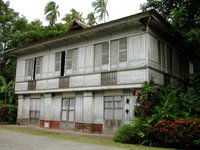 Camiguin is the second smallest province of the Philippines both in size and population. Only Batanes is smaller. But with a population density of 232 people per square kilometer, it is the 16th most densely-populated province.
Camiguin is the second smallest province of the Philippines both in size and population. Only Batanes is smaller. But with a population density of 232 people per square kilometer, it is the 16th most densely-populated province.There are two ports in Camiguin that receive ferries from Balingoan, the one in Guinsiliban which is used by those with vehicles, and the one in Barangay Benoni in Mahinog which is the main passenger terminal since it is closer to Mambajao. There is another port in Barangay Balbagon, Mambajao but this is for Cebu-bound ferries. The fare from Balingoan is PHP100 plus a PHP7 terminal fee. The trip takes approximately an hour and 15 minutes. We left a little past 2 p.m.
 I arrived in Benoni at about 3:30 p.m. and took a jeepney from the terminal to Mambajao for PHP26. The trip was about 30 minutes. While on board the jeepney, I was floored by the number of ancestral homes still standing in Camiguin. The province continues to retain its character and old world charm. I would later learn after reading the DOT website that "Camiguin Island is famous for its ancestral homes gracefully dotting the streets all over the island" as well as its eight volcanoes which is why it is referred to as the island born of fire.
I arrived in Benoni at about 3:30 p.m. and took a jeepney from the terminal to Mambajao for PHP26. The trip was about 30 minutes. While on board the jeepney, I was floored by the number of ancestral homes still standing in Camiguin. The province continues to retain its character and old world charm. I would later learn after reading the DOT website that "Camiguin Island is famous for its ancestral homes gracefully dotting the streets all over the island" as well as its eight volcanoes which is why it is referred to as the island born of fire.I got off in the poblacion area and asked people at the municipio where I could find cheap lodging. Good thing there was a pension house a few meters away. I got an air-conditioned room at the GV Pension House good for two people for PHP500. A non-aircon room is PHP350.
 After freshening up, I went straight down to find a ride around town. I wanted to see as much as I could before dark. The hotel staff were very helpful and they got me a habal-habal which would take me to the sites in Catarman as well as the Ardent Hot Springs for just PHP300. It was worth it since he took me around for about 4 hours. The going rate for renting a motorcycle for 8 hours is PHP500 and that doesn't include gas and a driver.
After freshening up, I went straight down to find a ride around town. I wanted to see as much as I could before dark. The hotel staff were very helpful and they got me a habal-habal which would take me to the sites in Catarman as well as the Ardent Hot Springs for just PHP300. It was worth it since he took me around for about 4 hours. The going rate for renting a motorcycle for 8 hours is PHP500 and that doesn't include gas and a driver. Our first stop was the Sunken Cemetery in Barangay Bonbon, Catarman. On the way, I saw even more ancestral houses (above). As we neared Cataraman, I was treated to out of this world vistas of the Camiguin coastline, Mount Hibok-Hibok and Mount Vulcan Daan (left) up close.
Our first stop was the Sunken Cemetery in Barangay Bonbon, Catarman. On the way, I saw even more ancestral houses (above). As we neared Cataraman, I was treated to out of this world vistas of the Camiguin coastline, Mount Hibok-Hibok and Mount Vulcan Daan (left) up close. The sunken cemetery used to be part of the old capital of Camiguin. According to local historians, Mount Vulcan had four recorded eruptions. It was the third eruption in 1871 that sunk Cotta Bato and its cemetery under the sea. Remnants of the structures and gravestones were still seen during low tide but the fourth eruption in 1948 buried the area deeper by around twenty feet. In 1982, a large cross was built on the solidified lava to mark this old gravesite that has become known as the sunken cemetery and one of the world’s most unique diving sites since the coral-encrusted tombstones can be visited by divers.
The sunken cemetery used to be part of the old capital of Camiguin. According to local historians, Mount Vulcan had four recorded eruptions. It was the third eruption in 1871 that sunk Cotta Bato and its cemetery under the sea. Remnants of the structures and gravestones were still seen during low tide but the fourth eruption in 1948 buried the area deeper by around twenty feet. In 1982, a large cross was built on the solidified lava to mark this old gravesite that has become known as the sunken cemetery and one of the world’s most unique diving sites since the coral-encrusted tombstones can be visited by divers. After a few photos, we went to the ruins of the old church which was on top of a hill. The marker calls it the church of Cotta Bato, but some accounts call it the old church of Gui-ob. The walls, and parts of the belltower and convento are all that remain of this church.
After a few photos, we went to the ruins of the old church which was on top of a hill. The marker calls it the church of Cotta Bato, but some accounts call it the old church of Gui-ob. The walls, and parts of the belltower and convento are all that remain of this church.We then went back to the pension house so that I could change for the visit to Ardent. The hot spring was six kilometers from the poblacion in Barangay Tagdo, Mambajao. It is the most popular of Camiguin's hot springs. In the resort is a natural pool of about 40 degrees celsius coming from the bowels of Mt. Hibok-Hibok. The best time to go for a swim is late in the afternoon up to the evening, it closes at 10 p.m., so that you could really appreciate the warm water. You pay a PHP30 entrance fee.
 While I was getting “warmed” up, it started to rain. So I stayed in the water a bit longer hoping the rain would stop. But it didn’t. So I decided to have dinner at the place. The food was nothing great and quite expensive. It was not worth it. If it only stopped raining I would have eaten dinner in the town proper.
While I was getting “warmed” up, it started to rain. So I stayed in the water a bit longer hoping the rain would stop. But it didn’t. So I decided to have dinner at the place. The food was nothing great and quite expensive. It was not worth it. If it only stopped raining I would have eaten dinner in the town proper.Since it didn’t seem like the rain would stop, I decided to leave when the rain started to weaken. All I could remember was that I was shivering all the way back since I was soaking wet, the temperature was quite cold, and it was drizzling. I went straight to bed as soon as I got back to the pension house since I lacked sleep and I needed to be up at 5 a.m. the next day.
More photos of Camiguin in Multiply.

Hi there Ivan,
ReplyDeleteMeron din Camiguin Island sa Cagayan Valley diba?
Parehas din ng "Palawan" , as in Palawan beach sa Sentosa?
I'm not sure. I haven't explored the off shore islands in the Cagayan Valley yet.
ReplyDeletethank you for your topic about camiguin. there are lots more about camiguin that u need to visit. and i am proud of my hometown mambajao, camiguin. and i am proud to tell my friends about your blog about camiguin so they get to see for themselves what to expect, how much is the cost. hope theres a blog about the various hotel or inn rates or what food specialty they offer. so more will be interested to visit the place not only camiguin and promote tourism for the place. thanks for your blog it really helps my hometown as well as the travellers. more power for your future travels
ReplyDeletehi ivan! do you have the contact number/s of GV pension house? i plan to visit camiguin in january. thank you very much!
ReplyDeleteMi and my fiance are visiting camiguin soon, I would like to ask if you have some tips when it comes to saving money for food there.
ReplyDeletehi Ivan,
ReplyDeletemy family and i are going to camiguin tomorrow. your write up about the place is really, really helpful.
thanks.
celia g. valdez
hi ivan,
ReplyDeletekudos to your contribution in the heritage conservation society. thanks for including kuguita elementary school's gabaldon building. me, my brods and sisters studied there. it's sentimental to us because our mother is the 6th grade teacher until her retirement.
and that led me to your very nice and informative weblog where i found our ancestral house, the 2nd one in this page. it was built by our lolo paulino dagondon in 1913. 6 years na lang centennial house na ito. i hope it will be included, too, in the society. as a side info, joel disini's (dotPH) maternal grandma, grew up in this house, too.
there are more buildings and ancestral houses around camiguin waiting for your return, pare.
keep up the good work and more power to you!
nandy dagondon
- first manager of camiguin telephone cooperative
MISSING ;
ReplyDeletehello po sa lahat, baka po may nakakakilala ke Marcelo & Saturnina Cabalhin, lolo & lola kopo sila, kasi po matagal ng patay si tatay ko. pangalan po ni tatay ko Bonifacio Cabalhi, pumutok po dati ang hibok hibok vulkan hinde napo sya nakabalik sa bisaya, napunta po sya sa manila maliit palang po sya, baka po may nakakakilala sa mga relativ ni tatay ko dyan sa hibok hibok?? sana po may magbigay ng impormation sa akin,, maraming salamat po.. regards Carmina Cabalhin .... carminapinas@yahoo.de
Nice blog, am very interested in the photo of the house you took, was that taken in Catarman? I think I know that house.
ReplyDeleteI'll have to check my Multiply to be sure. I labeled the photos there
ReplyDelete